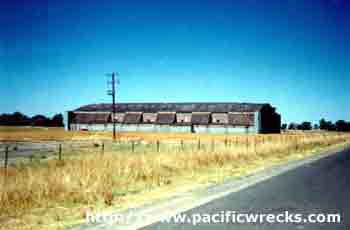|
|
|
|
| Missing In Action (MIA) | Prisoners Of War (POW) | Unexploded Ordnance (UXO) |
| Chronology | Locations | Aircraft | Ships | Submit Info | How You Can Help | Donate |
|
 Daniel Leahy 2001 |
Location Lat 35° 48' 42S Long 145° 36' 29E Tocumwal Airfield is located near Tocumwal near the Newell Highway in New South Wales (NSW) near the border with Victoria in Australia. Prewar, the property at this location was owned by the Hawkins, Keough, Hearn, Batters and Thorburn families. Also known as "Tocumwal Field", "RAAF Tocumwal Station" or "McIntyre Field". Construction During February 1942, this location was selected for development into a major Allied base on the so-called "Brisbane Line" to defend southeastern Australia. Property owners were given only a day to vacate. The first runway was built at this location by 2,700 construction workers from the Allied Works Council working day and night in five weeks using commandeered equipment. In total, four runways were built plus 112 km of roads and taxiways to support heavy bomber operations. In addition a railway line and platform at the field plus seven hangars and hundreds of other buildings including a 200 bed hospital. The airfield was completed by the end of April 1942 after sixteen weeks of construction at a cost of six million dollars. Known as Tocumwal Flying Field or Tocumwal Airfield and at the time was the largest airfield in the Southern Hemisphere. Wartime History During late April 1942, used by the U.S. Army Air Force (USAAF) as their main base in Australia with 7,000 personnel based at this location. On July 25, 1942 designated McIntyre Field in honor of Captain Patrick W. McIntyre who was killed on June 5, 1942. During November 1942, McIntyre Airfield was handed over to the Royal Australian Air Force (RAAF) and became known as Tocumwal Airfield or RAAF Tocumwal Station. At the height of operations, there were 5,000 RAAF and 400 WAAF personnel based here including the 82 Wing, No. 5 Operational Training Unit (5 OTU) operating Beaufighters, Bostons and Mosquitos and No. 7 Operational Training Unit (7 OTU) flying the Liberator and No. 7 Aircraft Depot (7 AD) and No. 7 Central Recovery Depot (7 CRD). Allied units based at Tocumwal Airfield (McIntyre Field) U.S. Army Air Force (USAAF) units 36th Air Service Group (36th ASrG) 1942–November 20, 1942 Royal Australian Air Force (RAAF) RAAF Station Tocumwal arrives November 14, 1942 Paratroop Training Unit (PTU) Laverton November 16, 1942–April 12, 1943 Richmond No. 7 Aircraft Depot (7 AD) Corowa December 2, 1942–February 14, 1946 disbanded No. 5 Operational Training Unit (5 OTU) Wagga Wagga Oct 20, 1943–July 1944 Williamtown No. 7 Operational Training Unit (Liberator) formed February 15, 1944–November 30, 1945 disbanded No. 7 Central Recovery Depot (7 CRD) formed June 15, 1944–October 7, 1946 No. 2 Recruit Depot (2 RD) Bradfield Park February 4, 1943– February 16, 1944 Cootamundra Postwar On February 14, 1946 when No. 7 Aircraft Depot (7 AD) departed, their facilities were taken over by Care & Maintenance Unit Tocumwal. During the 1950s, hundreds of aircraft were broken up and smelted into aluminum pots, pans and ingots. Tocumwal was officially closed as a RAAF base during October 1960. Scrapping continued until at least 1963 and many of the buildings were sold or removed. Today Still in use today as Tocumwal Airport. Airport codes ICAO: YTOC, IATA: TCW. Two runways remain in use the first is designated 27/09 and measures 3,937' x 98' surfaced with asphalt. The second is designated 36/18 and measures 4,596' x 98' surfaced with asphalt. Tocumwal Airfield has a number of wartime structures that remain including three of the original hangars. One of which is currently being used by the Sportavia Soaring Center as a hangar for gliders. Two of the four runways have been removed while the remaining two have been shortened and are still in use. The old taxiways are now roadways between the airport and a number of farms. Engine testing cells are now used as hay and machinery storage sheds. Original concrete fuel tanks are still being used to store fuel by Mobil while fuel pumps which look to be in working condition can still be found in the area. The old gate and guardhouse to the base are now used as the gate to the golf club and I have been told some of the old bunkers are now actually mounds on the golf course. The remains of the RAAF's No. 5 Hospital are located about three miles from the airfield. An old water tower and remains of one of the buildings can be found a short distance from one of the roads and a memorial is on the roadside. Tocumwal Historic Aerodrome Museum Located at the airport, devoted to the history of the airfield. References Oz@War Tocumwal Airfield During WWII Tocumwal Historic Aerodrome Museum - A Brief History of Tocumwal Aerodrome Thanks to Daniel Leahy for additional information Contribute
Information Last Updated
|
Map Fallingrain Photo Archive |
| Discussion Forum | Daily Updates | Reviews | Museums | Interviews & Oral Histories |
|